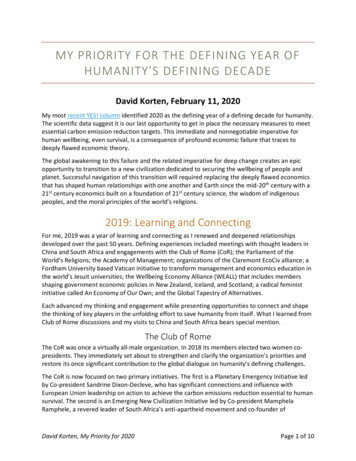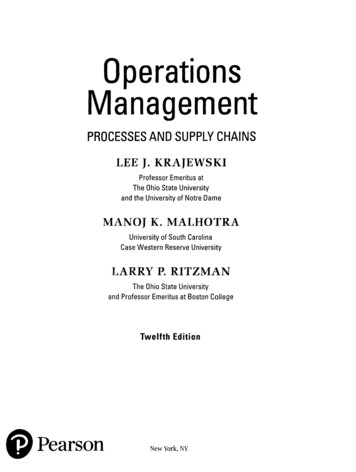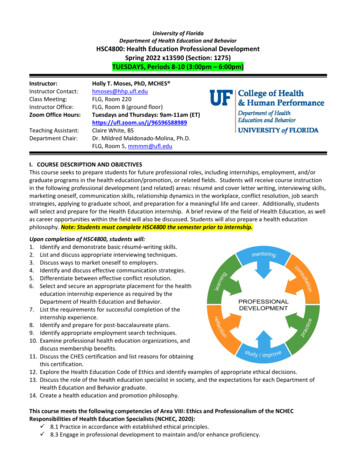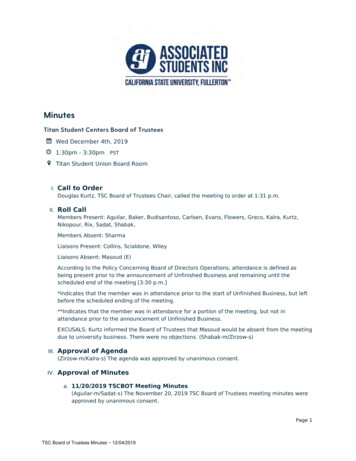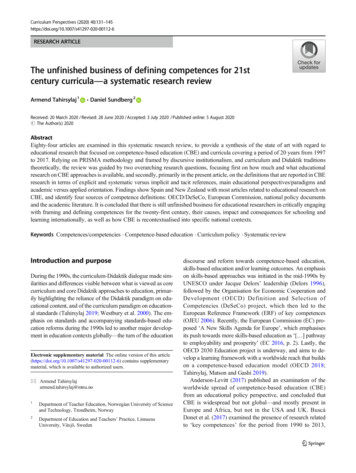
Transcription
Curriculum Perspectives (2020) 12-6RESEARCH ARTICLEThe unfinished business of defining competences for 21stcentury curricula—a systematic research reviewArmend Tahirsylaj 1&Daniel Sundberg 2Received: 20 March 2020 / Revised: 28 June 2020 / Accepted: 3 July 2020 / Published online: 5 August 2020# The Author(s) 2020AbstractEighty-four articles are examined in this systematic research review, to provide a synthesis of the state of art with regard toeducational research that focused on competence-based education (CBE) and curricula covering a period of 20 years from 1997to 2017. Relying on PRISMA methodology and framed by discursive institutionalism, and curriculum and Didaktik traditionstheoretically, the review was guided by two overarching research questions, focusing first on how much and what educationalresearch on CBE approaches is available, and secondly, primarily in the present article, on the definitions that are reported in CBEresearch in terms of explicit and systematic versus implicit and tacit references, main educational perspectives/paradigms andacademic versus applied orientation. Findings show Spain and New Zealand with most articles related to educational research onCBE, and identify four sources of competence definitions: OECD/DeSeCo, European Commission, national policy documentsand the academic literature. It is concluded that there is still unfinished business for educational researchers in critically engagingwith framing and defining competences for the twenty-first century, their causes, impact and consequences for schooling andlearning internationally, as well as how CBE is recontextualised into specific national contexts.Keywords Competences/competencies . Competence-based education . Curriculum policy . Systematic reviewIntroduction and purposeDuring the 1990s, the curriculum-Didaktik dialogue made similarities and differences visible between what is viewed as corecurriculum and core Didaktik approaches to education, primarily highlighting the reliance of the Didaktik paradigm on educational content, and of the curriculum paradigm on educational standards (Tahirsylaj 2019; Westbury et al. 2000). The emphasis on standards and accompanying standards-based education reforms during the 1990s led to another major development in education contexts globally—the turn of the educationElectronic supplementary material The online version of this ) contains supplementarymaterial, which is available to authorized users.* Armend Tahirsylajarmend.tahirsylaj@ntnu.no1Department of Teacher Education, Norwegian University of Scienceand Technology, Trondheim, Norway2Department of Education and Teachers’ Practice, LinnaeusUniversity, Växjö, Swedendiscourse and reform towards competence-based education,skills-based education and/or learning outcomes. An emphasison skills-based approaches was initiated in the mid-1990s byUNESCO under Jacque Delors’ leadership (Delors 1996),followed by the Organisation for Economic Cooperation andDevelopment (OECD) Definition and Selection ofCompetencies (DeSeCo) project, which then led to theEuropean Reference Framework (ERF) of key competences(OJEU 2006). Recently, the European Commission (EC) proposed ‘A New Skills Agenda for Europe’, which emphasisesits push towards more skills-based education as ‘[ ] pathwayto employability and prosperity’ (EC 2016, p. 2). Lastly, theOECD 2030 Education project is underway, and aims to develop a learning framework with a worldwide reach that buildson a competence-based education model (OECD 2018;Tahirsylaj, Matson and Gashi 2019).Anderson-Levitt (2017) published an examination of theworldwide spread of competence-based education (CBE)from an educational policy perspective, and concluded thatCBE is widespread but not global—and mostly present inEurope and Africa, but not in the USA and UK. BuscàDonet et al. (2017) examined the presence of research relatedto ‘key competences’ for the period from 1990 to 2013,
Curric Perspect (2020) 40:131–145132relying only on the ERIC education database. They identifiedsome 600 articles related to ‘key competences’ but did notundertake a content analysis of those articles. As a result, verylittle is known from the educational research perspective abouthow CBE approaches have been taken up by researchers internationally, or what research questions have been addressedwhen examining competence-based curricula. Davies (2000)argued that educational policy and practice gain much fromsystematic reviews and research syntheses. In our systematicreview, 84 articles are examined to explore the CBE approaches through an educational research lens. The reviewaims to provide a synthesis of the state of the art with regardto educational research focused on competence-based education and curricula, covering a period of 20 years—startingwith 1997, as the first year after Delors’ report in 1996—to2017.The starting point for the review was guided by a two-partoverarching research question, asking (a) How much researchis reported in the peer-reviewed literature about competencebased education, competence-based curricula, key competences, and key competencies? and (b) What are the geographical distribution, topical categories, education levels, subjectmatter domains, research methodologies, and key findings ofstudies in CBE research? In the present article, we also focuson the definitions and operationalisation of key terms such ascompetence/competences and competency/competencies,asking (c) What definitions are reported in CBE research interms of explicit and systematic versus implicit and tacit references, main educational perspectives/paradigms, and academic versus applied orientation? The rest of the article isstructured as follows: first, a brief summary of competencebased education approaches and ERIC-based review on ‘keycompetences’ is provided; next, an elaboration of theoreticalframework is offered; then, results and findings are presentedorganised around guiding research questions, and lastly, thearticle ends with a critical discussion of the results andconclusions.number of definitions of competence, covering a broader setof source definitions. Anderson-Levitt further lists theEuropean Commission, OECD, UNESCO and EuropeanUnion as key international and multi-national institutions fromwhich CBE approaches originated, lists France (in 1992) andBelgium (1994) as the first two countries in the world to haveadopted CBE in their primary and secondary curricula andalso shows the spread of CBE approaches to other regionssuch as Africa and Australia. Enthusiasm for CBE has waxedand waned over the years as countries have had to navigatecompeting interests nationally and transnationally. AndersonLevitt’s (2017) findings can be compared with those of thepresent study as regards whether a ‘different’ geography ofCBE approaches emerges when examining them from an educational research rather than an educational policyperspective.Buscà Donet et al.’s (2017) analyses included basicbibliometric characteristics, articles and corresponding descriptive statistical analyses. Their results show that the largestnumber of articles was related to higher education and the‘Other’ category, rather than primary and secondary education, and therefore we expect that our results will differ, andcomplement their study’s findings. They also found that themajority of articles in their sample were about competencediscourse and implementation issues, significantlyoutnumbering those related to classroom application.Interestingly, Buscà Donet et al. (2017) did not examine thegeographical distribution of ‘key competence’-related articles,and rely on the definition of ‘competence’ in the EuropeanCommission and European Union’s recommendation foreight key competences proposed in 2006 (OJEU 2006), relating the rise of key competences movement in European Unionto OECD’s DeSeCo project. In this regard, the present articlewill substantially contribute to a broadening of definitions andunderstandings of ‘key competences’, competences and/orcompetencies.Competence-based education approaches in previousresearchTheoretical frameworkAnderson-Levitt (2017) and Buscà Donet et al. (2017) areagain the two most recent and comprehensive studies beforethis article, which builds on their findings, and expands andcomplements their scopes of coverage and analyses.Anderson-Levitt’s (2017) study based on policy documentanalysis encountered issues with definitions of competencesand competence-based education. Anderson-Levitt (2017 par.15) provides a definition of ‘key competencies’ as proposedby the OECD’s DeSeCo project, and the present article adoptsher definition of competence-based education, which ‘refersto any approach aiming to enable students to develop particular competences’. Our review sheds further light on a largerThe purpose of exploring and mapping the way thatcompetence-based education has been framed and definedin research calls for a theoretical framework that can differentiate the different aspects of discursive processes at play(Wahlström and Sundberg 2018). When examining definitions of competences, it is not only the explicit definitionthat is of interest. Implicit taken-for-granted assumptionsare also important, as they provide the philosophical andideational substance of the definitions. Nordin andSundberg (2016) for example found that the four mostwell-spread global frameworks for competence-based education came from learning theories and learner-centred curriculum ideology (in broad terms, behaviourism and
Curric Perspect (2020) 40:131–145constructivism), which provide both foundational premisesand the framing of definitions. These assumptions could betermed ‘the background ideas’, following Vivien Schmidtand her work on discursive institutionalism (Schmidt 2015).According to Schmidt (2015), background ideas are coreprinciples that are taken-for-granted and institutionalised,and rarely contested except in time of crises. ‘Foregroundideas’, on the other hand, are the ideas and concepts structuring education programs and reforms in policy-making.These ideas and definitions are used in discursive interaction to maintain and/or alter institutions and their patterns ofactions. The theoretical point of departure in this study is todirect attention to the background ideas and implicit knowledge traditions in curriculum policy-making through the useand framing of the key concepts and definitions that areplaced as foreground ideas (Wahlström and Sundberg2018). In other words, specific knowledge traditions(Whitty and Furlong 2017) provide the background assumptions for the common and widespread definitions ofCBE that are rarely made explicit. Only a few studies havespecifically looked into the issue of how education researchhas contributed to the transnational discourse on CBE interms of explicit/implicit references, background ideas andthe academic/applied orientation (see for example Voogtand Roblin 2012).The second definitional aspect concerns the backgroundideas that frame the most commonly used definitions ofcompetence-based education. Deng and Luke (2008) andSchiro (2013) differentiate between four main curriculum paradigms with historical and current influence on the purposesof schooling, curriculum content, the definition of subject matter and the framing and definitions of competences. Academicrationalism (with emphasis on disciplinary knowledge) involves content-oriented curricula where competences are subsidiary to mastering disciplinary knowledge in problem solving situations. In a similar vein, in social reconstructionism(emphasising the use of schooling for social reforms), knowledge and competences are generally instrumentally framed toachieve future-oriented societal aims such as justice, equalityand equity. Social efficiency focuses on equipping future adultcitizens with the requisite skills, knowledge, and capital foreconomic and social productivity under current conditions.According to human capital theory, education is primarily aform of capital, similar to financial instruments, since withmore education and investment in skills and knowledge, individuals become more employable and increase their economicvalue in the job market (Becker 1962; Schultz 1961). Thesepropositions grew out of economic research that linked investment in human capital to national economic output (Schultz1961). Since OECD, as an economic think tank, has focusedclosely on the competence movement and the EuropeanCommission recommended eight key competences to makeEuropean Union more competitive economically (Buscà133Donet et al. 2017; OJEU 2006), it is important to revisit thecompetence definitions from the economic perspective of human capital, as the foreground idea, as well as, and perhapsmore importantly, background ideas, which place the emphasis more on skills and knowledge, and primarily on the technical skills that make individuals employable and productive.Learner-centred curriculum ideology, lastly, places emphasison the development of individual learners who pursue personal development, self-actualisation, innovation and creativity toadapt to the ever-changing knowledge economy in a flexibleand accommodating way.The third definitional aspect concerns theoretical versusapplied orientations of the used definitions. Furlong andWhitty (2017) proposed a three-cluster categorisation ofknowledge traditions in education, academic, practicaland integrated, based on the findings from seven countries:England, France, Germany, Latvia, the USA, China, andAustralia. In Furlong and Whitty’s (2017) conceptualisation, the academic cluster covers ‘singulars’ within the fieldof education, which are well-defined and bounded, and theindividual disciplines of education and the German educational theory of Didaktik are included. The other traditionsfalling under academic categorisation are those that defineeducation as a ‘region’ and ‘applied’ educational researchand scholarship and the ‘new science’ of education are included here, as well as the Anglo-Saxon version of curriculum research. The second cluster of practical knowledgetraditions included four other candidates: education as ‘generic’ (competences and standards), the ‘normal’ collegetradition of teacher education, liberal education plus craftknowledge and networked professional knowledge. Lastly,in the third cluster of integrated knowledge traditions,Furlong and Whitty (2017) list Pedagogija (based onLatvian practise), practitioner enquiry/action research,research-informed clinical practice, and learning sciences(for further elaboration see Whitty and Furlong 2017). It isuseful for the present review to discuss the findings relatedto academic versus applied knowledge traditions, and howthey have framed and informed the various definitions usedin CBE.MethodologyThis study is a systematic review, and more specifically fallswithin the ‘narrative reviews’ category, as the goal is not toseek generalisations but to identify and analyse key issuesrelated to CBE from an educational research perspective(Davies 2000; Educational Research Review n.d.). The searchstrategy relies on the preferred reporting items for systematicreviews and meta-analyses (PRISMA) framework (Liberatiet al. 2009), which is one of the most well-established frameworks for systematic reviews and meta-analyses. The
Curric Perspect (2020) 40:131–145134PRISMA framework outlines key stages in order to search forarticles, develop inclusion and exclusion criteria and evaluatearticles that are part of the sample. We used the following foursearch terms: ‘competence-based education’, ‘competencebased curriculum’, ‘key competences’, and ‘key competencies’ in five major international social science databases:ERIC, Scopus, Springer Link, Taylor & Francis Online andWeb of Science. The inclusion criteria were based on (1) thetype of publication, including journal articles and conferenceproceedings; (2) timeframe: 1997–2017; (3) field of study:education (or social sciences), (4) language: English and (5)peer-review. Exclusion criteria were (1) not primary or secondary education; (2) vocational education; (3) not aboutcompetence-based education and (4) no full-text accessible.Whenever possible, the inclusion criteria were applied usingfilters available in the databases, and exclusion criteria wereapplied by reading article abstracts. For the content analysis inthe final stage, first, a sample of five articles were reviewed byboth authors to reach a consensus on data/topic/concept extraction from articles, and the rest of the articles were dividedbetween the two authors and reviewed individually. As theresults are categorised into topics, definitions, genres andmethods, the study offers a valuable explorative map of research into competence-based education. The state-of-the-artreview thus summarises existing and the emerging policy, andpractice trends, as well as research priorities and issues forfurther research. Table 1 briefly summarises the search framework based on the PRISMA model, including the four stages,Table 1initial and final number of records in the data pool, and inclusion and exclusion criteria.To ensure consistency in the analytical step between thereviewers/authors, we next developed a matrix template asan analytical tool with which to extract relevant and consistent information from each of the articles in the final pool.Table 2 shows the specific entries on which the review wasbased on.In order to provide an in-depth analysis and synthesisof the articles in Stage 4 (n 84), we divided the workinto three parts (and eventually three articles). First, weprovide a general overview of the articles in Stage 4 (n 84), and then narrow the focus to definitions andoperationalisations of key terms competence/competencesand competency/competencies; the second part focuses onrecords grouped around curriculum policy (n 38); andthe third part covers records in the curriculum implementation category (n 45). The present article focuses on thefirst part (see Table 3 under results and findings fordetails on topical categories). We first offer a generaloverview of articles in the final sample, and then wefocus on the definitions of the key terms, an issue thatemerged inductively as we processed with the review, andwhich begs for a detailed critical analysis in its own rightin order to capture the broad and diverse spectrum ofdefinitions, and potentially clarify their use in futureresearch.Search strategy framework (PRISMA model)Bibliographic DatabasesERIC; Scopus; Springer Link; Taylor & Francis Online; and Web of ScienceStage 1 Search (n 2673)Search terms: ‘competence-based education’, ‘competence-based curriculum’, ‘key competences’, and ‘keycompetencies’.Stage 2 ScreeningInclusion Criteria: (1) type of publication: journal articles & conference proceedings; (2) timeframe: 1997-2017;(3) field of study: education (or social sciences), (4) language: English, and (5) peer-reviewed.State 3 EligibilityExclusion Criteria: (1) Not in primary and secondary education; (2) In vocational education; (3) Notabout competence-based education and (4) No full-text accessibleState 4 Analysis and synthesis (n 84)Results
Curric Perspect (2020) 40:131–145Table 2 Matrix templatefor competency-basededucation (CBE) systematic review1351. Country/ region2. Education level(Primary, Lower-secondary,Upper-secondary or a combinationthereof)3. Subject matter4. Main topic(s)/ objective(s)5. Competence or competency, and is itdefined?Provide definition if Yes.6. Main research question(s) (if any)7. Theoretical framework(s) / if any8. Data, participants, & sampling (ifapplicable)9. Methods (qualitative or quantitative)/briefly describe10. Key results/ findings / conclusions11. Does article report use of researchfunding? If Yes, provide detailsTable 3 Emerging topical categories identified and grouped at differentstages of reviewInitial categories (7)Then, collapsed into 5categoriesCurriculumpolicy/keycompetences (38)Curriculumimplementation/key competencesdevelopment (22)Curriculum policy/Key CBE Curriculumcompetences (38)Policy/Key competences (38)CurriculumCBE ces devel(Curriculumopment (22)Implementation Student-related Teacher-related EducationalLeadership(22 12 8 3 45)Teacher-related educationalleadership(8 3) 11Teacher-Related (8)Educationalleadership (3)Student assessment(7)Student perceptionsof CBE (5)ERIC-based review(1)Final categories (3)Student-related(student assessment studentperceptions ofCBE/keycompetences)(7 5 12)ERIC-based review (1) ERIC-based review (1)Results and findingsAs regards the first part of the overarching question about howmuch research pertains to the four search terms of interest, theinitial search for articles across the five databases returned thefollowing results: 1284 articles related to ‘key competencies’,847 related to ‘key competences’, 371 related to ‘competencebased education’ and 171 related to ‘competence-based curriculum’—2673 articles in total. Different databases returneddifferent numbers of articles as expected, with 253 articles inERIC, 380 in Springer Link, 467 in Scopus, 590 in Web ofScience and 983 in Taylor and Francis Online. The resultssuggest an overlap of articles across both the four search termsand the databases, due to cross-indexing. Figure 1 summarisesthe results per search term and per bibliographic database.Certainly, there is more peer-reviewed literature in otherdatabases, which was not indexed in the searched databases.Eighty-four records remained after applying inclusion and exclusion criteria in Stage 4 (as shown in Table 1), with themajority of excluded articles belonging to one of the followingfive main categories: medicine, vocational education andTraining (VET), higher education, duplicates and not inEnglish. Nevertheless, considering the number of search termsapplied and the number of databases covered, our review captures a representative sample of records belonging to the fieldof educational research on competence-based education informal schooling, covering primary, lower-secondary andupper-secondary general education levels. While the totalnumber of articles returned in the initial search across databases is relatively large, the final number of records in Stage 4(n 84) shows that the overwhelming majority of articles didnot belong to the narrow scope of our study: the majority ofthe articles did not ‘survive’ the inclusion and exclusioncriteria applied. The results of the second part of the overarching research question follow, focusing only on the records inStage 4 (n 84).General overview of records in Stage 4 (n 84)The second part of the overarching research question focuseson a number of descriptive indicators, such as geographicaldistribution, topical categories, education levels, subject matter domains and research methodologies, in order to obtain abroad overview of the records, before delving into the indepth analysis, which focuses on the definitions of key termssuch as competence/competences and competencycompetencies.Figures 2 and 3 illustrate the distribution of records in Stage4 (n 84) across countries/regions and continents/regions respectively. The ‘international’ designation in the two figuresindicates studies that focused on two or more countries, or hada broad focus without specifying any country in particular.
136Curric Perspect (2020) 40:131–145Fig. 1 Initial number of recordsper search term per bibliographicdatabase (Stage 1, n 2673)A few results need highlighting from Figs. 2 and 3. Therecords related to individual European countries and Europeas a continent far outnumber the others, with nearly 60% ofarticles (n 47) falling into this geographical area, indicatingthat competence-based education in formal primary andFig. 2 Number of records percountry/region (Stage 4, n 84)secondary schooling has largely been a European affair sofar, at least from the educational research perspective.Secondly, the complete lack of records from South America,and almost complete lack of records covering North America(n 1, from Canada) and Africa (n 2) show that educational
Curric Perspect (2020) 40:131–145137Fig. 3 Number of records percontinent/region (Stage 4, n 84)research into CBE in these continents has been missing, according to our scope, and inclusion and exclusion criteria.Asia (n 11) and Oceania (Australia and New Zealand) (n 11), are in the middle of the spectrum, as are studies with aninternational focus (n 11). As regards individual countries,the records from Spain (n 11), New Zealand (n 10), theUK (n 6), and the other countries in the European Unionas a region (n 7) significantly outnumber the rest in our finalpool. Spain and New Zealand are clearly outliers, with studiesfocusing on CBE approaches, mirroring the comparativelyearly adoption of CBE curriculum policies in these twocountries—Spain in 2006, and New Zealand in 2007. Again,the geographical distribution here only indirectly indicates thespread of CBE policies internationally through educationalresearch related to CBE, and primarily shows the focus ofeducational researchers on CBE policy and implementation.Of 84 records, 75 (89%) were journal articles, and 9 (11%)were conference proceedings articles.We next grouped records into topical categories, first tohave a broad overview of what the articles are primarily about,and secondly, to make the in-depth analysis more manageable.The topic categories emerged inductively after a detailed reading of abstracts and full articles, and we provide them accordingly for each stage of our analysis, in Table 3.In the final categorisation, the articles were divided intothose focusing on CBE curriculum policy, which discussedCBE and/or key competences approaches through policy analysis, mostly theoretically, and overwhelmingly through qualitative methodology, and CBE curriculum implementation,where all articles deal with aspects of CBE implementation,either focusing on specific key competences within certainsubjects, or related to teacher understandings of, or competence regarding CBE, or related to student perceptions of CBEor student assessment in CBE. The ERIC-based review waspart of the final pool, but stood out as a comprehensive review,as presented and discussed in the introduction to the presentarticle. As already noted, an in-depth analysis of articles focusing on curriculum policy and curriculum implementation isnot part of the present article, instead it focuses on theconceptualisations of the competence/competences andcompetency-competencies key terms.Figure 4 presents the distribution of records across variouseducation levels, and Fig. 5 shows the distribution of recordsacross various subjects.In terms of education levels, most records were either broadin their scope and do not specify any particular educationlevel, or focus on upper-secondary education levels. This evenmore so regarding the subject matter domains, with 59 out of84 records (nearly 70%) being general and not specific inscope. In terms of research methodologies, 66 records out of84 (78%) were qualitative, 15 (18%) were quantitative and 3(4%) were mixed-methods in nature.Figure 6 shows the distribution of records according to yearof publication.As Fig. 6 shows, the distribution follows the adoption ofCBE as a policy, with the majority of the records publishedafter 2010. Funding was not reported by 64 out of 84 (76%),and in the 20 (24%) that reported funding, it was mostly fromthe relevant national ministries of education.Definitions of competence/competences andcompetency/competenciesFindings related to the second research question on definitionsconcerning competenc(i)es are presented here. The articles inthe final pool of our systematic review seem to use key termssuch as ‘competence/competences’ and ‘competency/
138Curric Perspect (2020) 40:131–145Fig. 4 Distribution of recordsaccording to education levels(Stage 4, n 84)competencies’ interchangeably. Figure 7 shows this varieddistribution.As shown in Fig. 7, 31 out of 84 articles (or 37%) usedcompetences, 23 (or 27%) competencies, and 30 (36%) usedboth. In terms of defining these concepts, 58 out of 84 (69%)provided a definition, and no specific definition was offered in26 (31%). Appendix 1 in the supplemental material shows thelist of all 84 articles, and whether they provided a definitionfor ‘competences’ and/or ‘competencies’ or not, as well asinformation about the source of the definition, and whetherthe definition focused on ‘competences/competencies’ in general, or specifically, such as on an individual competence suchas ‘learning to learn competence’, for example, and referencesarticles used to support their use of definitions.1The variations and consistency in spellings of ‘competences’ and/or ‘competencies’ was an unexpected result ofthe review that might not be resolved in the near future.Variations in the use of either competences or competenciesonly add to the linguistic confusion surrounding these terms.The DeSeCo publications during the late 1990s and early2000s, for example, use ‘competence’ and ‘competency’ insingular and then switch to ‘competencies’ and/or ‘key competencies’ in plural only, and ‘competences’ is not used at all(OECD 2005; Rychen et al. 2002). The European Union andthe European Commission in the European ReferenceFramework (OJEU 2006) use ‘competence’ and ‘competences’ only. In our review, we find that the countries whichused the European Reference Framework as a source for CBE1A complete table with definitions is available upon request, and not providedhere due to space and word limitations.policy also follow the European Commission convention ofusing ‘competence’ and ‘competences’, with Spain being themajor example, and countries tha
The unfinished business of defining competences for 21st century curricula—a systematic research review Armend Tahirsylaj1 & Daniel Sundberg2 Received: 20 March 2020/Revised: 28 June 2020/Accepted: 3 July 2020 . with framing and defining competences for the twenty-first century, their causes, impact and consequences for schooling and


